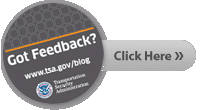It is with great pleasure that I begin my first official blog post at the TSA. I arrived at HQ last week with aspirations common to most recent college graduates. Pumped full of “unique” ideas that could potentially change the entire world, I decided to start with the TSA. My plan was simple and straight forward. I just needed someone in a position of authority to lend me their ear.
While my “unique” ideas are certain to be called into question from time to time, as a recent college graduate, my writing will attempt to synthesize an outsider’s perspective with insider knowledge. Having monitored the ongoing debate between TSA authorities and the public, I’ve discovered that both sides are (believe it or not) in agreement more often than they realize.
Since I don’t have the frontline experience like my colleague Bob, I’ll be spending the next few weeks meeting people here at TSA, spending time at local airports, and monitoring the blogosphere to see what other folks are talking about to come up with blog topics to cover.
Since I’ve come on board, I’ve spent some time at Baltimore Washington International Airport’s Southwest Airlines’ Terminal B learning about Checkpoint Evolution [
link]. Like many travelers, the first thing I noticed was a wall of holograms and a faint blue glow from the lights lining the perimeter. As I wound my way through the line, I was greeted every so often by portraits of security officers (sometimes out of uniform) with brief bios below their pictures. Clearly, the intent behind these signs is to remind us that Transportation Security Officers (TSOs) are people just like the rest of us, and dedicated to their security mission. It was interesting to see that some are veterans or former law enforcement officers.
So here’s the overarching theory: when the checkpoint environment is calm and the majority of passengers lined up at a security checkpoint are relaxed (or as relaxed as anyone can reasonably be when trying to catch a flight), a suspicious person will oftentimes stand out in stark contrast from the rest of the crowd. Also, encouraging clear communication between security officers and passengers helps passengers understand the “why” behind the rules, and facilitates the flow of traffic through the security checkpoint.


Sure, lights and signs are nice, but they are not in and of themselves the main focus of Checkpoint Evolution. Aside from targeted technological improvements—such as Whole Body Imaging, advanced technology X-ray machines, and inter-officer communication via ear-piece—the greatest benefits to security and passengers’ experience come from one thing in particular: enhanced training. TSA officers I met at BWI have completed a 16-hour training course (although training is ongoing) that focuses on explosives detection, intelligence analysis, and techniques for improved passenger engagement, with the ultimate goal being threat detection. This training will be given to every frontline employee, and has already started in some airports.
I asked the BWI officers what they thought of Checkpoint Evolution and the response was very positive. “It has made our job a lot easier,” said one of the officers. “Striking up a casual conversation with passengers allows us to get a better feel for the situation—not to mention that it makes our day more pleasant.”
Next, I hope to attend some of the training sessions to see what they’re like and get more feedback. I’ll report on that later.
Now for the all important question: What do passengers think? I haven’t had the chance to chat with any Checkpoint Evolution veterans just yet, but if you’ve been through BWI’s Southwest Airlines’ Terminal B, let us know what you think by posting comments.
Labels: mission





